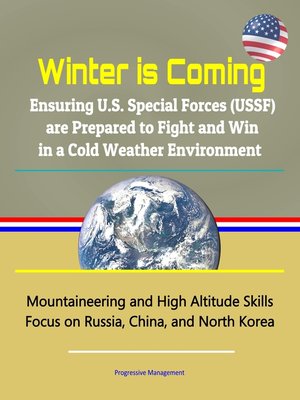Winter is Coming
ebook ∣ Ensuring U.S. Special Forces (USSF) are Prepared to Fight and Win in a Cold Weather Environment--Mountaineering and High Altitude Skills, Focus on Russia, China, and North Korea

Sign up to save your library
With an OverDrive account, you can save your favorite libraries for at-a-glance information about availability. Find out more about OverDrive accounts.
Find this title in Libby, the library reading app by OverDrive.



Search for a digital library with this title
Title found at these libraries:
| Loading... |
This late 2018 report has been professionally converted for accurate flowing-text e-book format reproduction. For the past 17 years, United States Special Forces (USSF) has been decisively engaged in the Global War on Terror. Due to the deployment cycle and training requirements focused on deployments in the Middle East, many valuable skillsets, including the ability to fight, maneuver, and survive in extreme cold weather environments has atrophied across the force. In a majority of USSF units, extreme cold weather training is synonymous with high altitude and mountaineering training. Some teams and units do specialize in this type of terrain and train to a high level in technical mountaineering tasks, but too often the focus is on technical mountaineering skills and not how to survive and sustain operations in extreme cold weather environments. The recent 2018 National Defense Strategy, the multi-domain battle concept, and actions taken by peer and near-peer adversaries, all call for a shift in focus from the Middle East to adversaries such as Russia, China, and North Korea. Conflict with any of these adversaries will likely include some aspect of cold weather warfare. This research effort will define an adequate cold weather capability for USSF, and make recommendations to reach that capability.
This compilation includes a reproduction of the 2019 Worldwide Threat Assessment of the U.S. Intelligence Community.
I. Introduction * A. Background * B. Research Question * II. Historical Context * A. Winter War * B. Korean War * III. Literature Review * A. Doctrine * B. Academic Papers * C. Norwegian Cold Weather Training and Doctrine * IV. The Threat and Current Capability * A. Potential Hot Spots for Cold Weather Warfare * B. USSF Current Capability * V. Required Capability * A. Antarctic Methodology * B. Cold Weather Framework * C. Measuring Capability * D. Recommendations to Build Capability * VI. Conclusion * A. Command Emphasis Must be Placed on Cold Weather Readiness * B. Leadership in Cold Weather Warfare * C. Recommendations for Future Study
The Multi-Domain Battle (MDB) concept is an approach for the U.S. to counter peer and near-peer adversaries in the 2025-2040 timeframe. The MDB concept calls for small, scalable, self-sustained units, to operate autonomously in hostile or denied environments against a peer or near-peer adversary. High-end war with North Korea, Russia, or China would certainly involve fighting in the cold, and as such, units need to be prepared to operate in that environment. While no unit would truly be able to "self-sustain" in an extreme cold environment, any amount of training that will improve survivability and lethality will benefit those units within the joint force required to operate in extreme conditions. Under the MDB concept, units must be capable operating in any operational environment.






